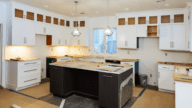How Much Value Does Crown Molding Add to Your Home, or Does It Just Add a Certain Elegance?
- Published on
- 8 min read
-
 Summer Rylander, Contributing AuthorClose
Summer Rylander, Contributing AuthorClose Summer Rylander Contributing Author
Summer Rylander Contributing AuthorSummer Rylander is a freelance writer and editor with an abundant background in real estate. A former residential real estate agent in the Columbia, SC area and sales administrator at a commercial real estate firm, she now uses this experience to help guide readers. Summer currently resides in Nuremberg, Germany, where she fulfills her passions of food and travel and avoids her dislikes of mayonnaise and being trapped in an office.
-
 Sam Dadofalza, Associate EditorClose
Sam Dadofalza, Associate EditorClose Sam Dadofalza Associate Editor
Sam Dadofalza Associate EditorSam Dadofalza is an associate editor at HomeLight, where she crafts insightful stories to guide homebuyers and sellers through the intricacies of real estate transactions. She has previously contributed to digital marketing firms and online business publications, honing her skills in creating engaging and informative content.
“How can I add value to my home?” You ponder, wandering from room to room while refreshing your online banking app, confirming that while you have a bit of cash to play with, it’s not in the cards to finish the basement or overhaul the kitchen.
You pause just long enough to stretch, and as your head tilts back and your eyes sweep from wall to ceiling, it hits you: “What about crown molding?” So, you wonder how much value does crown molding add to your home?
Crown molding 101
A decorative element usually made of wood or plaster, crown molding is a cornice between the top of a wall and the ceiling. It’s also found above kitchen cabinets, doorways, or windows, rightfully earning its reference to a crown.
While its function is mostly cosmetic and the designs vary widely, crown molding has long been an admired architectural detail that adds depth, texture, and elegance to a room.
Despite its traditional connotations, crown molding can enhance a home of any architectural style. When properly executed with consideration to ceiling height and design rules for proportion, contour, and white space, crown molding suits a wide array of rooms as well.
Common styles of crown molding include:
- Federal: This style is great for adding a visual boost to low ceilings. Its elegant yet understated design helps create the illusion of height in smaller spaces.
- Early American: This molding style is low-key and subtle, making it a perfect choice for homeowners who prefer a minimalist look. It enhances the space without overwhelming the decor.
- Colonial Revival: This style has an upscale feel but embraces a “less is more” approach. It provides a refined touch without being overly ornate, making it versatile for different interiors.
- Classical Revival: Traditional and dignified, this molding style brings a sense of timeless elegance to a room. It pairs well with other classical architectural elements like wainscoting and coffered ceilings.
- Greek Revival: Simple in design, this style is meant to evoke the look of Greek columns. It works well in homes with grand, stately features or those inspired by neoclassical architecture.
Crisp whites and shades of cream are common color choices for crown molding, though the right selection depends on your ceiling height and personal preference. When used as an accent feature above cabinets or windows, crown molding tends to look most cohesive when the color matches the cabinetry or window frame.
As with most aesthetic finishes, craftsmanship is key when it comes to crown molding. Shoddy installation or a slapdash paint job will not only look bad, but it can also make a potential buyer wonder what’s hiding underneath. If you’re thinking of adding crown molding to your home, the intent should be to enhance a room’s appearance, not to hide cracks, stains, or other wall or ceiling damage.
How much does crown molding cost?
Your walls are in good shape, and you’re curious to price out some crown molding options and see if it’s worth the investment. Where to start?
The average cost for crown molding ranges from $4 to $23 per linear foot, depending on the material and the labor cost in your area. Wood molding tends to be more expensive due to the skilled carpentry required to cut and install it. Overall, expect to pay between $611 and $2,120 to have crown molding professionally installed.
Naturally, less investment is required if you’re only installing in select rooms or using crown molding to accent cabinets or framing.
Does crown molding add value?
Crown molding is tricky in that it’s one of few home improvement endeavors where the cost of installation can exceed the cost of materials.
“The return on investment for crown molding is usually positive, though it depends on how you use your money,” says a representative from Focal Point Products, producers of polyurethane crown molding kits in Greenwood, Delaware. “Crown molding can be quite difficult to install, […] the project could cost thousands.”
If you’re the handy type or happen to have a carpenter in the family, you might be able to install crown molding yourself and save some cash that way. It’s worth reaching out to fellow homeowner friends or neighbors for their recommendations on local renovation contractors. Most will offer free or low-cost consultation, so you’ll know what you’re getting into before you commit to signing any checks.
As far as crown molding adding value to a home?
In Tampa, Florida, top real estate agent Christina Griffin does not see a big demand for crown molding from her clients. Aside from the occasional buyer who chooses crown molding as an add-on option in a new-construction property, the detail has never been the tipping point on a sale or valuation.
“I’ve done thousands of [broker price opinion] BPOs, and when we adjust values and put houses right next to each other and an appraiser goes in, there isn’t much of an adjustment for crown molding,” says Griffin. “A fresh coat of paint would add more value than crown molding, in my opinion.”
Is crown molding worth installing?
While no one likes to hear, “It depends!”, crown molding tends to be a matter of personal preference. Some love it, and some don’t even notice the added grandeur.
“I think it goes to style,” says Pat Tasker, a top agent based in Milwaukee, Wisconsin. “I think it’s usually an indication of higher-quality build and more attention to detail.”
That said, Tasker would not advise a seller in her market to add crown molding to their home in hopes of increasing value prior to sale.
“I mean, [crown molding] is desirable, but it’s emotional value. It doesn’t add any financial value,” says Tasker.” [Homeowners] are better off putting in real hardwood floors than crown molding.”
Input from home appraiser Cody Bunch of For What It’s Worth Appraisals in Myrtle Beach, South Carolina, aligns with agent feedback. Crown molding theoretically can add value, but it’s not a given.
“Similar to [adding] a pool, the improvement has value, but the market in which it exists determines the effect,” says Bunch. “There is no clear answer. Crown molding, paint, updated flooring, updated fixtures, etc. can all be improvements which increase the marketability of a home and in turn provide an increase in value, but these improvements are usually not dollar for dollar.”
Which rooms benefit most from crown molding?
Not every room needs crown molding, but in the right spaces, it can make a huge impact. Here’s where it works best:
- Living room: Crown molding adds elegance and makes the space feel more polished by creating a seamless transition between walls and ceilings. It also enhances traditional or classic design styles, giving the room a timeless appeal.
- Dining room: It elevates formal dining areas by adding a sense of refinement and architectural interest. The right molding can make even a simple dining space feel more upscale and inviting.
- Master bedroom: A touch of crown molding brings luxury and sophistication, making the room feel like a high-end retreat. As part of bedroom staging, it helps frame the ceiling beautifully, especially in rooms with tray or vaulted ceilings.
- Hallways and entryways: These often-overlooked spaces can feel more intentional and finished with the addition of crown molding. It draws the eye upward, adding depth and visual interest to otherwise plain areas.
However, some rooms don’t really need crown molding. Low-ceilinged basements or ultra-modern, minimalist spaces might not benefit since the molding can feel out of place or make the room seem smaller.
So, what’s the verdict?
If you’ve fallen in love with the idea of crown molding and this hasn’t been the evaluation you were hoping for, don’t fret. Instead of making it a whole-house project, consider adding crown molding to just one or two rooms to play up the “wow” factor. A formal dining room or living room can be a great space to add decorative molding selectively.
Alternatively, you can use crown molding as an accent above prominent doorways or windows, or you might turn your attention to the kitchen.
“It is a nice finish to put on cabinets,” says Tasker. “Crown molding gives a really nice, finished touch versus just the raw square edges, and a homeowner could do that themselves.”
Finally, don’t hesitate to consult a real estate agent. Every housing market is different, and an expert in your area will be the best resource for advice on whether adding crown molding to your home would be a smart move before listing.
Explore HomeLight’s Home Improvement resources for tips and ideas on projects that will help add value to your home and make it irresistible to buyers.
Header Image Source: (John Wollwerth / Shutterstock)




